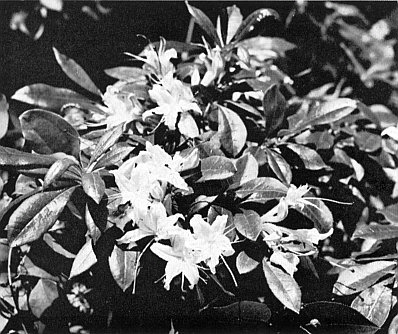QBARS - v23n1 Rhododendrons At Callaway Gardens 1969 ARS Convention Site
Rhododendrons At Callaway Gardens 1969 ARS Convention Site
F. C. Galle, Pine Mountain, Ga.

|
|---|
Fig. 4. Sweet Azalea, R. arborescens , has clean and attractive foliage. A few individuals have large flowers. Photo courtesy the U.S. National Arboretum . |
Fifteen years ago, very little information was available on growing hybrid evergreen rhododendrons in the south. In fact, the common advice of many authorities was that the plants were not suitable and would die. It is true that many species and hybrids are not adaptable, with our present knowledge, and that plants have died. We can also state that while hybrid rhododendrons are a challenge, we can now recommend many cultivars for southern gardeners.
Mr. Cason Callaway's reply to "they say" - was that most of the "they sayers" had never tried and were perpetuating misinformation. With this encouragement, Callaway Gardens started a Rhododendron Trail in 1953. Over 150 cultivars and species have been tried with approximately 70 still doing well. Each year, additional plants are obtained for evaluation. The high summer temperatures of the south were originally pointed out as being the main problem in growing rhododendrons. While the long warm summer temperatures are not to be overlooked, there are other problems equally as difficult. Fluctuating winter temperatures can also be detrimental to many of the rhododendrons with a hardiness rating of H-3 and H-4. Normal winter lows for this area would be 5° to 15° with 10° generally considered as average. Low temperatures are generally of short duration and often follow a period of cool to warm weather. Variations of 35° to 40° temperature in a day are not uncommon. One extreme recorded in 1961 showed a change from 68° to a -4°, a drop of 72° in less than 12 hours.
Soil borne diseases, particularly rhododendron wilt or root rot, are common in the south and present a problem. Flower bud blasting in the fall is also a major fault with some cultivars, and it varies with conditions. A fall rain with cool temperatures following a warm summer offers ideal conditions. October is often noted to be the driest month of the year. Irrigation is necessary to prevent plants from dying, due to lack of soil moisture. We have not been able to provide irrigation without having fall bud blasting.
In spite of these challenging difficulties, the Rhododendron Trail at Callaway Gardens is usually at its peak of color in mid-April. This particular trail, nearly a half-mile in length, will be one of the main features during the ARS Convention, with special tours being conducted by the horticultural staff. Other guided tours will be taken on the Azalea Trail and the Wild Flower Trail.
It would be impossible to list all the rhododendrons that have been tried or even those that we feel are best adapted to this area. One general observation is that the old "iron clad" cultivars (H-1 and H-2), for the most part, do well in this climate. Of the 70 varieties on the trail, 24 are referred to as "iron clads" and it is from this group of plants that we generally make recommendations for the south. There are always exceptions; 'Lee's Dark Purple' (H-2) is notorious for its blasting of fall buds.
The following is a partial list of rhododendrons, with hardiness ratings, found on the trail:
| H-2 | H-3 | |||
|---|---|---|---|---|
Sappho |
Amy |
Vulcan |
Lee's Adapted |
|
The Bride |
Blue Peter |
Jan Dekens |
Annie E. Endtz |
|
Princess Elizabeth |
Cynthia |
Alice |
Pink Pearl |
|
Mars |
Bagshot Ruby |
|||
The list of rhododendron species at present is still small, but does include R. fortunei , R. minus , R. ovatum and R. micranthum .
Callaway Gardens becomes a floral fairyland in the spring. The horticultural staff of the Gardens is looking forward to serving as guides and to interpreting this 2,500 acre woodland wonderland.

